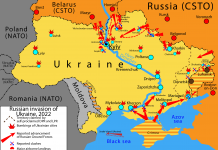
On April 1, 2025, China’s state media released footage detailing a large-scale military exercise conducted by the People’s Liberation Army (PLA) Eastern Theater Command, designated “Strait Thunder-2025A.” The drills, which involved live-fire demonstrations in the Taiwan Strait, showcased the deployment of PHL-191 multiple launch rocket systems (MLRS), a key component of China’s evolving precision-strike doctrine. The exercise prominently featured the launch of 16 guided rockets, successfully engaging eight simulated targets, including a mockup of Taiwan’s Yong’an liquefied natural gas (LNG) terminal in Kaohsiung—a critical node in the island’s energy infrastructure.
Conducted in the central and southern sectors of the Taiwan Strait, the exercise carries significant strategic implications, particularly as analysts interpret it as a rehearsal for targeting critical Taiwanese assets in a potential contingency. The selection of the Yong’an LNG terminal underscores the PLA’s operational emphasis on degrading Taiwan’s energy resilience, a move that would severely constrain the island’s ability to sustain prolonged defensive operations in the event of conflict. Given that LNG accounts for approximately 40% of Taiwan’s power generation, with Yong’an processing a substantial portion of those imports, its loss would have far-reaching consequences, both militarily and economically.
At the forefront of this exercise was the PHL-191, a modular, wheeled MLRS capable of firing both conventional and precision-guided munitions. Mounted on an 8×8 chassis, the system can carry modular pods configured for eight 370mm rockets or larger-caliber ballistic projectiles, including the 750mm Fire Dragon 480 missile. With reported engagement ranges exceeding 300 miles, the PHL-191 represents a significant leap in China’s ability to conduct long-range fires against fixed infrastructure targets. The demonstrated accuracy in this exercise suggests integration of advanced guidance technologies, likely employing a combination of satellite and inertial navigation systems.
The PLA’s selection of the PHL-191 reflects a shift in operational focus—from massed area-denial bombardments to precision-strike capabilities, enabling targeted neutralization of adversary assets with minimal collateral damage. This evolution mirrors developments in Western rocket artillery, such as the U.S. Army’s High Mobility Artillery Rocket System (HIMARS). While the PHL-191 boasts a heavier payload and greater range compared to HIMARS, it lacks the latter’s air-transportability and rapid redeployment capabilities. Comparatively, Russia’s Tornado-S MLRS offers similar reach but lacks the modular flexibility of China’s platform, highlighting Beijing’s strategic emphasis on adaptable firepower suited for regional engagements.
Beyond the technical dimensions, “Strait Thunder-2025A” serves as a deliberate signaling effort to multiple audiences. Domestically, it reinforces nationalistic narratives, demonstrating the PLA’s preparedness to enforce Beijing’s claims over Taiwan. Externally, the exercise projects deterrence, particularly toward Taipei and its primary security guarantor, the United States. A PLA spokesperson, Colonel Shi Yi, characterized the drills as a “stern warning and strong deterrent against Taiwan independence separatist forces,” a statement widely disseminated through state-controlled media outlets. The explicit targeting of an energy infrastructure site also carries a psychological component, aiming to induce strategic uncertainty among Taiwanese defense planners and policymakers.
Taiwan’s Ministry of National Defense swiftly condemned the exercise as “provocative” and reiterated its commitment to national defense. The island has invested significantly in counterstrike and missile defense capabilities, including U.S.-supplied Patriot PAC-3 interceptors and the indigenous Sky Bow III system, both designed to engage incoming ballistic threats. However, the PHL-191’s salvo capabilities, particularly if paired with decoy munitions or electronic warfare tactics, present a formidable challenge to Taiwan’s defensive architecture.
The broader geopolitical response was predictably critical. The U.S. State Department labeled the drills as “destabilizing,” while Japan and the European Union issued statements emphasizing the importance of maintaining stability in the Taiwan Strait. Given Japan’s proximity and reliance on uninterrupted maritime traffic through these waters, Tokyo has a vested interest in deterring escalation. Meanwhile, Beijing continues to accelerate military modernization efforts, with the Stockholm International Peace Research Institute estimating China’s 2024 defense budget at $230 billion. The frequency of PLA exercises in the region—most notably the 2022 encirclement drills following then-House Speaker Nancy Pelosi’s visit to Taiwan—suggests that “Strait Thunder-2025A” is part of an enduring pattern rather than an isolated event.
This latest demonstration further complicates strategic calculations in Washington. The PLA Navy, now boasting over 350 ships, has surpassed the U.S. Navy in fleet size, while China’s growing inventory of precision-strike assets, including the PHL-191, enhances its capacity for rapid, high-intensity operations against fixed targets. The Pentagon, long focused on countering a potential PLA amphibious invasion of Taiwan, may need to recalibrate its contingency planning to account for the increasing role of stand-off precision fires in China’s military doctrine.
Historically, the Taiwan Strait has remained a high-risk flashpoint since 1949, when Nationalist forces retreated to the island following their defeat in the Chinese Civil War. While previous crises, such as the 1996 missile tests near Taiwan, were deterred by U.S. carrier deployments, the current balance of power is more ambiguous. Exercises like “Strait Thunder-2025A” illustrate China’s growing ability to shape the battlespace long before direct confrontation, underscoring the urgency for regional stakeholders to adapt to an evolving strategic reality.
Whether this exercise is merely another step in Beijing’s pressure campaign or a precursor to more aggressive action remains to be seen. However, the Taiwan Strait—already one of the world’s most volatile maritime chokepoints—has once again become a focal point of great power competition, with implications that extend far beyond East Asia.




